One of the best ways of getting to grips with the functions and applications of disclaimers is to consult a variety of disclaimer examples. Particularly if you plan on publishing any disclaimers personally, consulting approved disclaimer examples beforehand is the way to go.
But what is a disclaimer and where should disclaimers be used? Is it ever advisable to use an automated disclaimer generator, or is it better to learn how to write a disclaimer manually?
While disclaimers exist in a wide variety of forms, their basic purpose is usually the same. Whether it’s an important legal disclaimer or an everyday website/blog disclaimer, its purpose is to deny something and/or deny responsibility for something.
Protecting yourself and your interests from potential legal repercussions means knowing when, where, and how to use disclaimers appropriately.
What is a Disclaimer?
A disclaimer is a statement that limits your liability and is usually found on websites or apps. It can be used to protect you from any legal action that a visitor may take against you, by outlining the limits of what they can expect from using your website or app.
If you need a disclaimer, it’s important to make sure it covers all the potential liabilities of your business. This could include anything from giving advice to selling products, and even disclaiming warranties. Having a disclaimer in place will help protect you and your business if any legal issues arise.
It’s always best practice to use a disclaimer on any website or app that deals with sensitive information, as it helps to limit your liability should something go wrong.
Why is it Important to Have a Disclaimer?
It is important for small businesses to have a disclaimer in order to protect themselves from errors and omissions. A disclaimer helps inform users of any potential risks or liabilities associated with the product or service being provided by the business.
Having a disclaimer ensures that the business is not held liable for any damages resulting from products or services provided by them. Without a disclaimer, businesses could face costly legal action if something goes wrong, so it’s essential to create one as soon as possible.
Disclaimers also protect businesses from copyright infringement, so it’s important to ensure that your website or product has proper permission to use any images or content taken from other sources.
In conclusion, having a disclaimer is an important step in protecting your small business and informing users of potential risks associated with their purchase.
Free Disclaimer Generator?
Generate a disclaimer to comply with any legal or third-party requirements using this free disclaimer generator.
10 Popular Disclaimer Examples to Inspire You
The exact content and coverage of any given disclaimer will usually be 100% unique. However, the vast majority of disclaimers fall within one of the following categories:
- Affiliate Disclaimer
- Copyright Disclaimer
- Fair Use Disclaimer
- Confidentiality Disclaimer (for Emails)
- Warranty Disclaimer
- No Responsibility Disclaimer (Liability Disclaimer)
- Views Expressed Disclaimer
- Investment Disclaimer
- No Guarantee Disclaimer
- Past Performance Disclaimer
While it’s perfectly possible for there to be a degree of overlap between one or more disclaimer types, it is vital to understand how each type of disclaimer works and which meets your requirements. In addition, ensuring the content of the disclaimer is clear, concise, and unambiguous is also essential.
Let’s take a closer look at some of the most common types of disclaimers in a little more detail:
Affiliate Disclaimer
The FTC (and most good affiliate programs) requires that anyone taking part in an affiliate scheme publishes an acceptable affiliate disclaimer. At its core, an affiliate disclaimer is simply used to inform people that you are taking part in an affiliate program and stand to earn money by doing so.
An affiliate disclaimer will typically indicate that while the information and advice provided by the entity in question are predominantly objective, there may be a degree of bias due to their money-making intent.
Here’s an example of a concise affiliate statement from Amazon to illustrate the content you’re looking for:

Copyright Disclaimer
Typically the most concise of all disclaimers, a copyright disclaimer – aka a copyright notice – simply lets others know that the material they are accessing belongs to you. A copyright notice will typically include the name of the author, the year of the copyright, the internationally recognized copyright symbol and an indication of reservation of rights.
All such information will usually be presented in a concise ‘bar’ at the bottom of the page, though must be prominent enough to be visible. Here’s an example of a copyright disclaimer:
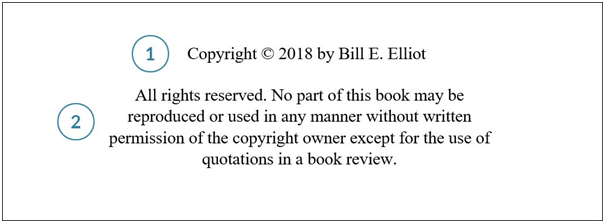
Fair Use Disclaimer
Anyone who intends to use the work of someone else without their direct permission may need to include a fair use disclaimer, which can prevent legal action from being taken against them.
‘Fair use’ refers to the use, citation, or incorporation of another author’s work to an extent that doesn’t contribute to copyright infringement or plagiarism. For example, the content may have been used by a third party for commentary purposes, teaching, researching, news reporting, and so on.
A common example of ‘fair use’ in practice is a movie review that includes clips from the film, or the use of extracts from a copyrighted book during an English language lesson.
Here’s a fair use disclaimer used by several YouTube Channel:
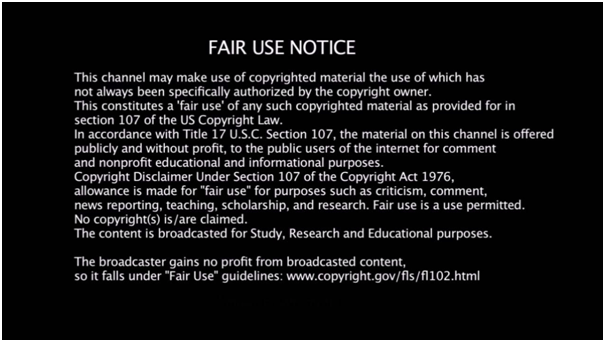
Confidentiality Disclaimer
Confidentiality disclaimers are usually part of the signature line in an email, which subsequently ensures that it appears in every email communication. These email disclaimers are used to inform the recipient that the content of the email is confidential in nature and must not be shared in full or in part with anyone else.
In addition, email disclaimers can sometimes be used to warn recipients of potential computer viruses and other security risks, thus limiting the liability of the sender in the case of such scenarios.
A typical confidentiality disclaimer used in an e-mail signature line is as follows (from Fasanara Capital):
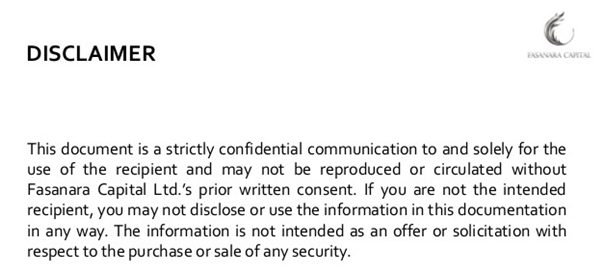
Warranty Disclaimer
As the name suggests, a warranty disclaimer is effectively the opposite of a conventional warranty. Where issued, a warranty disclaimer informs the receiver of the product or service the provider does not offer any promises or guarantees, typically in relation to the quality, dissatisfaction, and so on.
However, all sellers and service providers are bound by certain national and international rules regarding minimum quality and safety levels for products and services offered. Therefore, a warranty disclaimer cannot be used to sidestep all responsibility on the part of the seller or service provider.
This is how Amazon words its warranty disclaimer:
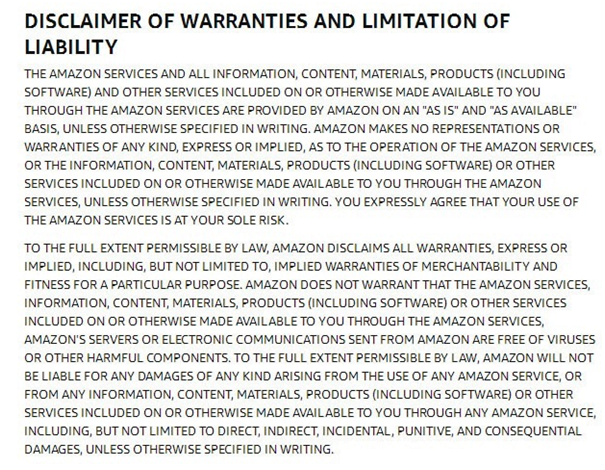
No Responsibility Disclaimer
Also referred to as a disclaimer of liability, a no-responsibility disclaimer offers protection from potential repercussions in a variety of scenarios. In simple terms, to take a position of ‘no responsibility’ is to accept no liability for the consequences that may occur, due to the use of the information or resources provided on your website (as an example).
This kind of disclaimer is used to inform people that if they take any given action, they take full responsibility for the potential consequences. Most websites feature one or more no-responsibility disclaimers, as online information and resources can be interpreted and acted upon in an infinite variety of ways.
Here’s the current no-responsibility disclaimer from BCS:
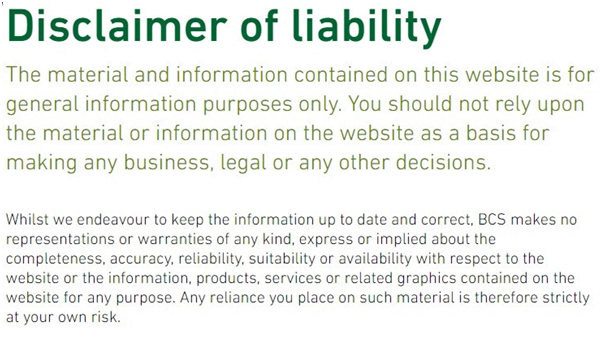
Views Expressed Disclaimer
One of the most important disclaimers for use in forums, blogs, and other online and offline publications, a ‘views expressed’ disclaimer distances the author or business from the content published.
The disclaimer informs readers that the content published (which may include guest posts, comments, replies, third-party entries etc.) in no way conveys the thoughts, sentiments or intents of the author, the website, or the business. This ensures that in the event any questionable or controversial content is published, the author/website is not held liable for the consequences.
Here’s a simple yet effective example of a views-expressed disclaimer:
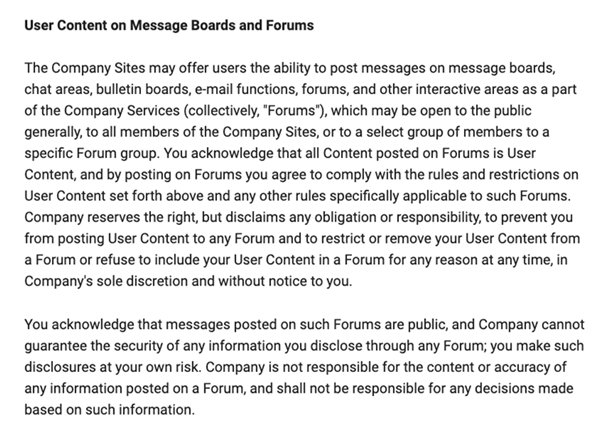
Investment Disclaimer
Specifically, it is used to inform the reader that the author is not a qualified financial adviser, investment specialist, dealer, or broker and that they cannot and will not guarantee the accuracy or completeness of the information they provide.
As a result, the reader accepts complete liability for the consequences that may arise, due to their use or interpretation of the information published.
A good example of an effective investment disclaimer from SilverBarter:

No Guarantee Disclaimer
Again, this means that irrespective of the outcome, the author or website accepts no liability or responsibility for the consequences. It is implied that the information/content is provided simply for reference purposes, rather than viable or valid advice to be followed.
Wikipedia has a simple yet effective no-guarantee disclaimer in place, which reads as follows:

Past Performance Disclaimer
Last up, the ‘past performance’ disclaimer is used to advise readers that future results can in no way be attributed to past performance. Hence, irrespective of the strong and successful past performance of any activity or entity, this doesn’t guarantee similar results in the future.
Past performance disclaimers are used to inform readers that in the event that they make decisions based on past performance alone, they accept full responsibility for the outcome. They are warned that such assumptions are neither advisable nor condoned by the author, therefore should be avoided.
Here’s how Maple Leaf Funds issues its past performance disclaimer:

What to Include in an Effective Disclaimer
An effective disclaimer should include a description of the limitations of the product or service being offered, as well as any potential liabilities that may arise from its use.
It should also provide a statement of warranty, and explain any disclaimers related to performance, availability, accuracy, and merchantability.
Additionally, it should list any conditions that must be met before using the product or service in question. Lastly, the disclaimer should set out the rights of all parties involved in using and accessing the product or service.
A good disclaimer will help protect both parties and ensure that their rights are respected. To help you, check out this list of important clauses to add to your disclaimer.
Limitation of Liability
A disclaimer that states that your business is not responsible or liable for any damage or loss caused by the use of your website content are a must.
This is a key component to protecting your business. You should include a disclaimer on your disclaimer page that limits your liability in case you are sued for something that occurred from the use of your website content.
Indemnification Clause
You should also include an indemnification clause in your disclaimer. This clause should state that your business is not responsible for any claims, costs, or damages that arise from the use of your website content.
It should provide protection for you in the event that a customer or other third party files a lawsuit against your business because of something related to the use of your website content.
Exclusion of Warranties
You should also include an exclusion of warranties in your disclaimer. This means that your business is not responsible for any warranties, expressed or implied, regarding the use of your website content.
This serves to protect you in the event that a customer or other third party makes a claim against your business due to a malfunction or error in the use of your website content.
Choice of Law
You should also include a choice of law clause in your disclaimer. This clause should state which jurisdiction’s laws will be used to settle any disputes that arise from the use of your website content. This is important to protecting your business from being sued in a jurisdiction that does not have the same laws as your business.
Severability Clause
Lastly, you should include a severability clause in your disclaimer. This clause should state that if any part of your disclaimer is found to be unenforceable, the remaining parts of the disclaimer shall remain in effect.
This is important to protect your business from having the whole disclaimer ruled invalid if one part of it is found to be unenforceable.
When deciding which type of disclaimer you need, it is important to consider these components and make sure that you have all of them included in order to effectively protect your business.
By understanding the content of each component and how it applies to your business, you can create a disclaimer that will help protect your business from any legal issues that may arise.
How to Write an Effective Disclaimer
A website disclaimer is one of the most important legal documents for any online business or website. It can help protect the site and its owners from potential legal issues arising from the content or activities on their website.
To write an effective disclaimer, it should be written in plain language so that anyone visiting the site can understand it, include a clear statement on the limits of liability, mention any applicable laws that may govern the site’s activities, and clearly identify who owns or is responsible for the website.
Additionally, disclaimers should be visible on every page of a website in order to maximize their effectiveness. By following these steps and making sure to keep your disclaimers up-to-date with any changes that occur in your business, you can ensure that your website has an effective disclaimer.
Understand Your Business
Before you can begin writing an effective disclaimer, it is important to understand your business and the types of risks it may face. Consider the products or services that you offer and the potential liabilities that they may create. Research common disclaimers in your industry to get a better understanding of what types of risks should be addressed in your disclaimer.
Consult with a Lawyer
Legal disclaimers can be complex, so it is important to consult with a lawyer to make sure that your disclaimer is accurate and legally binding. A lawyer can help you create a disclaimer that meets the legal requirements in your jurisdiction and is tailored to the needs of your business.
Consider Your Audience
When writing your disclaimer, consider the needs of your audience. Your disclaimer should be easy to understand and written in plain language. Avoid using technical legal terms so that they can be understood by all readers.
Write in Plain Language
When writing your disclaimer, it is important to use plain language. This means avoiding technical legal terms and using straightforward language that is easy to understand. Use simple words and sentences and avoid making assumptions about the reader’s knowledge.
Use Clear Formatting
The formatting of your disclaimer is just as important as the content. Use clear formattings such as headings, bullet points, and white space to make the disclaimer easier to read and understand. Place a disclaimer statement at the beginning of the document so that readers can quickly identify it.
Content
Your disclaimer should state that the information contained in your product or service is for informational purposes only and should not be interpreted as legal advice.
It should also state that you do not assume any responsibility for any omissions or errors in the information you provide. Furthermore, you should include a disclaimer to protect yourself from any potential liabilities that may arise from the use of your product or service.
Additionally, you should include a disclaimer to limit your liability for any damages that may arise from the use of your product or service. Finally, you should disclaim all warranties, including implied warranties, regarding the accuracy and reliability of the information contained in your product or service.
It should also be noted that the information contained in your product or service may also be used for other purposes without your consent.
Final Thoughts
As a business owner, having a disclaimer on your website is essential to protect yourself from potential legal issues. The disclaimer should include information on the privacy policy and terms and conditions of using the content on your website.
It is important to update this information regularly as laws change and new risks arise. Additionally, it should be easily accessible for visitors to understand what they are agreeing to when accessing your website.
Overall, having a clear and updated disclaimer is an important part of protecting both you and your customers from any potential legal issues that could arise from the use of your website’s content.
Comments are closed.